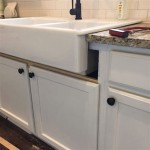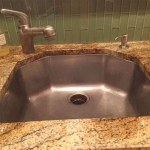Undermount Sinks for Laminate Countertops: A Guide to Installation and Considerations
Laminate countertops, known for their affordability and durability, are a popular choice for kitchens and bathrooms. When selecting a sink for such countertops, an undermount sink offers a sleek and modern aesthetic. Unlike top-mount sinks, which sit on top of the countertop, undermount sinks are installed beneath the countertop surface, creating a seamless and elegant look. Installing an undermount sink with laminate countertops, however, requires careful planning and specific considerations to ensure a successful outcome.
Understanding the Challenges
While undermount sinks are popular for their aesthetics, installing them on laminate countertops presents unique challenges. Unlike solid surfaces like granite or quartz, laminate is a thin, layered material that can be susceptible to damage during the installation process.
The primary challenge lies in the sink's mounting method. Undermount sinks are typically secured using clips or brackets that attach to the underside of the countertop. These clips can put pressure on the laminate, potentially causing it to chip, crack, or delaminate. Additionally, the undermount installation process often requires cutting a precise opening in the countertop, demanding careful and accurate execution.
Essential Considerations for Success
To install an undermount sink on a laminate countertop successfully, careful planning and adherence to specific guidelines are crucial. The following considerations will ensure a smooth and safe installation process:
Choosing the Right Sink
While the choice of sink style is primarily driven by aesthetics, selecting a sink with specific features is important for laminate countertops. Opt for sinks with a shallow bowl depth, as deep bowls can exert excessive downward pressure on the laminate. Additionally, consider selecting a sink with a thick rim, providing additional support and minimizing the risk of chipping or cracking.
Moreover, the sink's material is equally important. Stainless steel sinks are a popular choice due to their durability and resistance to stains and scratches. However, sinks made from composite materials, such as granite composite or quartz composite, can also be viable options. These materials are often more aesthetically pleasing and offer a wider range of color choices, but their durability and scratch resistance might not be as robust as stainless steel.
Careful Measurement and Template Creation
Accurate measurements are essential for successful installation. Before cutting the countertop, create a precise template using the sink's dimensions. This template will act as a guide for the cutout, ensuring a perfect fit and minimizing the risk of errors.
Consider using a professional template, available from sink manufacturers or countertop fabrication companies. These templates are designed to ensure an exact fit and simplify the cutout process. Alternatively, create your own template using a piece of cardboard or plywood. Mark the sink's dimensions on the material and cut the outline using a jigsaw or a utility knife.
Precise Countertop Cutting
The countertop cutout is the most critical aspect of the installation process. Use a jigsaw with a fine-tooth blade to cut the countertop, following the template precisely. Ensure that the blade is sharp and that the cuts are clean and even. Avoid using a circular saw, as it can create uneven cuts and weaken the laminate.
When cutting, use a slow and steady motion. Apply light pressure to avoid chipping or cracking the laminate. If using a jigsaw, support the countertop with a piece of plywood or a sturdy workbench to prevent flexing and ensure a straight cut.
Secure Installation and Support
After cutting the countertop, attach the sink using the provided clips or brackets. Ensure that the clips or brackets are properly positioned and tightened to provide sufficient support for the sink. If necessary, use a sealant or adhesive to secure the sink further and prevent water damage.
For added support, consider using a support plate or ring beneath the sink. This plate can distribute the weight of the sink evenly across the laminate surface, reducing stress and increasing the lifespan of the countertop.
Finishing Touches
After securing the sink, seal the edges of the countertop with a suitable sealant. This sealant will prevent water from seeping beneath the sink and damaging the laminate. Apply a thin layer of sealant along the edges of the cutout and allow it to dry thoroughly before using the sink.
For a truly seamless finish, consider applying a thin layer of caulk around the perimeter of the sink. This will help to create a smooth transition between the countertop and the sink and prevent water from seeping into the gap.
Conclusion
Installing an undermount sink on a laminate countertop requires careful planning and execution. By adhering to the guidelines outlined above, you can ensure a successful installation, minimizing the risk of damage to the laminate and creating a stylish and functional sink setup.

Undermount Sinks In Laminate Sims Countertops

Laminate Countertops Love Undermount Sinks Formica Group

An Undermount Sink In Laminate Countertops

Sink Options For Laminate Countertops

Beautiful Laminate Countertop With Undermount Sink My Blessed Life

Undermount Sinks In Laminate Sims Countertops

An Undermount Sink In Laminate Countertops

Beautiful Laminate Countertop With Undermount Sink My Blessed Life

An Undermount Sink In Laminate Countertops

Karran Undermount Sinks Counter Form







